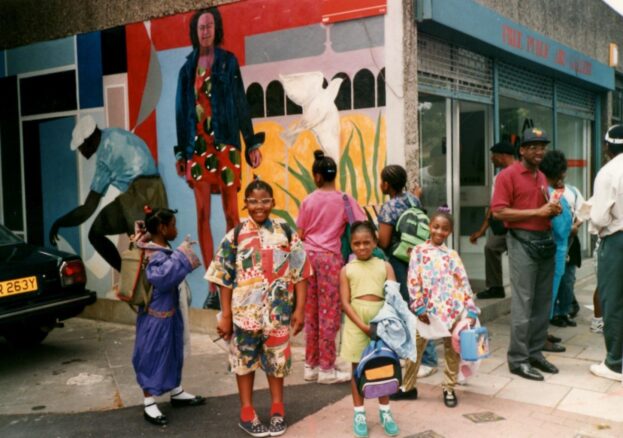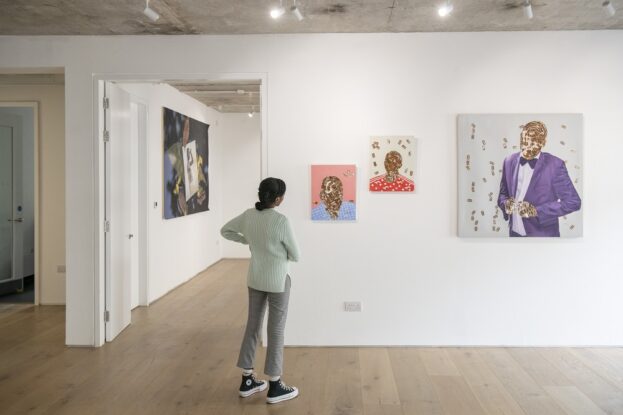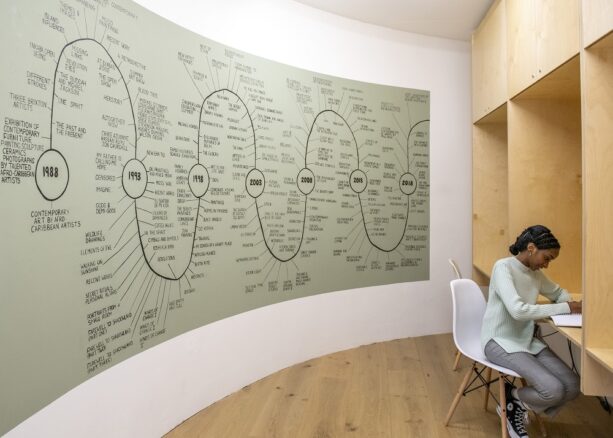
Steeped in radical history spanning over 50 years, Brixton’s Railton Road is home to 198 Contemporary Arts & Learning – a centre for visual arts, education, and creative enterprise. In 1988, founders Zoe Linsley-Thomas and John ‘Noel’ Morgan took over an unused shop unit on what was known as Brixton’s ‘front line’ after the uprisings and opened one of London’s first Black art galleries.
Initially showing artists from the African Diaspora, Zoe started reaching out to local primary schools to give children tours and activities around the creative arts. Soon the education programme was born, and 198 began offering training to local hard-to-reach youth, supporting them into further education and careers in the arts.
She worked the phones and fundraising appeals allowing her to grow the organisation by taking over a further two unused shop units, expanding the gallery and opening a dedicated education space, creating not only a space for local and international Black & Brown artists but also a site for education, enterprise and creative expression.
After its first exhibition ‘Contemporary Art by Afro-Caribbean Artists’, 198 went on to hold a space for many creative practitioners and hosted first exhibitions for some of today’s established names, such as Rotimi Fani Kayode, Denzil Forrester, Hassan Aliyu, and Barby Asante.
 198 survived and thrived over the next three decades, navigating the highly challenging fundraising landscape and continuing to evolve its artistic and educational programmes. After obtaining the freehold to their site in 2015, the organisation raised capital funds for a major construction project, building two new floors on top of the original structure. This has opened a plethora of new ways to support the local community and contributed to making the building more flexible and self-sustaining.
198 survived and thrived over the next three decades, navigating the highly challenging fundraising landscape and continuing to evolve its artistic and educational programmes. After obtaining the freehold to their site in 2015, the organisation raised capital funds for a major construction project, building two new floors on top of the original structure. This has opened a plethora of new ways to support the local community and contributed to making the building more flexible and self-sustaining.
In 2017, the organisation began working with Carver Haggard; a local architectural design and research practice, to develop the brief and design through joint workshops and live projects. The organisation went on to receive planning permission and GLA funding in 2018 and the project broke ground in early 2020, just as Brexit and Covid started to have an impact. Nevertheless, the building was completed on time and on budget and opened to the public as soon as Covid allowed, with a group show of Congolese artists: ‘Breaking the Mould: New Signatures from the Democratic Republic of Congo’. In 2022 the new building won the RIBA regional award for Urban Design.
Recently, with the possibilities of the new building the artistic program has flourished and showcased an array of talent. This September 2022 marks a year since the reopening of 198 Contemporary Arts & Learning, which has since shown works by upcoming and more established artists alike: including Amartey Golding, Pearl Alcock, Eva Sajovic. Part of the approach is to work with various curators and collaborators from the likes of Marlene Smith, British artist, and curator and one of the founding members of BLK Art Group, and Christine Eyene, art critic, art historian, and curator. This October the gallery welcomes back Ben F. Jones for ‘The Bigger Picture’, after showcasing his earlier works in 1994 for his show ‘In the Spirit’.

Nearly a year since its regeneration we asked what the new building means for 198 and the local community. Director Lucy Davies explains: “The Ben Jones show is an example of our work to support Black and Brown artists throughout their careers. We have long relationships with our artists and curators, often starting with them in their early careers and providing them with a safe space while they grow. We are a strong community of people with the common desire to support and celebrate the creative expression of people of colour. Our new building has given us fantastic exhibition space, and a whole floor dedicated to creative learning, as well as a floor of workspace for rent that helps us to build financial sustainability.
“The strength of our concept is to provide services to creatives throughout their life stages: we begin by introducing children to the potential of a future in the creative arts, then provide skills development to support young people as they develop their voice, and ultimately offer them a space to exhibit or start an enterprise. It’s like a spiritual home for your creative life.” Davies cites the Womxn of Colour Art Awards as a good example of 198’s work to uncover artists to watch, and provide opportunities for those who are so often marginalised. “We work to develop and provide an outlet for emerging Black and Brown voices in the arts and creative fields. We also bring the wisdom and experiences of our elders into the mix. For example, with oral history events like ‘A Life in Activism: An Audience with Leila Hassan Howe’ where she talks about her involvement with the struggles for racial equality and social justice, dating back to the black power era.”
According to 198’s chair, poet, activist and recording artist Linton Kwesi Johnson: “198 is a unique space in London as it is so much more than a Black art gallery. We have an enviable reputation for promoting excellence in the arts and continue to be committed to local relevance.”
